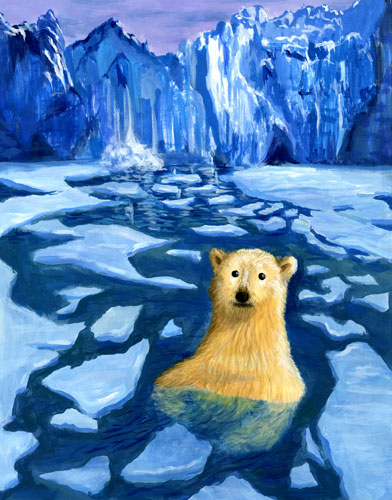A chilling life beyond politics is the weather, which is searingly bitter-cold right now across the US, and historical (CNN this afternoon):
Already, about 2,000 records for low temperatures have been shattered this past week, CNN meteorologist Dave Hennen said.
On Tuesday alone, at least 20 cities suffered their coldest weather in history. Many more new records are expected this week.
Oddly, but not — the cold is a product of climate change:
Bitter #cold remains across the Great Plains this morning and has spread to areas along the central and western Gulf Coast. More record lows were recorded today: pic.twitter.com/7ZPAEJIMgU
— NWS Weather Prediction Center (@NWSWPC) February 16, 2021
Details via Treehugger yesterday afternoon:
Climate deniers have often used cold winter weather to argue against the idea that industrial society is heating the planet through the burning of fossil fuels.
In one infamous example, Sen. James Inhofe (R-OK) brought a snowball onto the Senate floor to argue against the reality of global warming.Such arguments fundamentally confuse weather (temporary fluctuations) and climate (long-term trends).
But, counterintuitively, extreme wintry weather can actually be a sign of climate change.For one thing, a warmer atmosphere holds more moisture, which makes heavy precipitation more likely.
When the temperature is cold enough, that precipitation can fall as snow instead of rain.“If you can get a moisture source and these storms come through, they are more likely to have more intense precipitation,” Dr. Brenda Ekwurzel, director of climate science and a senior climate scientist at the Union of Concerned Scientists, told Treehugger in an interview.
The other reason is more complicated and involves the phenomenon forecasters have come to refer to as the polar vortex.
…
“Sometimes we use the analogy of when you open up a refrigerator door,” Ekwurzel explained, “and the cold air that’s in the refrigerator, that’s contained in there, escapes, and then the warm air in the room goes into the refrigerator.”So what does this have to do with climate change?
The polar vortex itself is not a new phenomenon, and NOAA says the term likely originated in 1853.
But the Arctic has been warming two to three times faster than the rest of the planet on average, and a growing body of observational research links this Arctic warming with extreme winter weather in Eurasia and North America, which has in fact increased in the past two decades.
..
However, Ekwurzel said that models had also failed to predict the extent of Arctic warming.
The problem is that it is a challenge for scientists to accurately model a climate that is so rapidly changing, meaning it is possible their models may have missed an important factor.“The past is not our guide to the future, or today,” Ekwurzel said.
The worse is apparently yet to come:
(Illustration found here).
However, here too, if we don’t remember the past we’re doomed — temps in the 1800s were way cooler than today. Yet because climate change continues unabated, maybe even has accelerated according to some studies, this type of seasonal outbursts can be expected into the immediate/distant future.
And the mention above that warmer air carries more moisture, we’ll be having heavier and heavier snow.
Also in a related subject, and the noted above that scientific fact-finding ‘may have missed an important factor,’ recent research indicates one of those is highly toxic greenhouse gas, methane, which is buried under Arctic ice, and now that same methane is being studied in the oceans — and methane is way dangerous: ‘“Methane doesn’t last as long in the atmosphere as carbon dioxide, but it’s much more efficient at trapping heat than carbon dioxide.”‘
New research in ‘submarine permafrost’ holding methane indicates it is little understood — particulars per Sandia National Laboratories last week:
According to 25 international researchers who collaborated on a first-of-its-kind study, frozen land beneath rising sea levels currently traps 60 billion tons of methane and 560 billion tons of organic carbon.
Little is known about the frozen sediment and soil — called submarine permafrost — even as it slowly thaws and releases methane and carbon that could have significant impacts on climate.To put into perspective the amount of greenhouse gases in submarine permafrost, humans have released about 500 billion tons of carbon into the atmosphere since the Industrial Revolution, said Sandia National Laboratories geosciences engineer Jennifer Frederick, one of the authors on the study published in IOP Publishing journal Environmental Research Letters.
While researchers predict that submarine permafrost is not a ticking time bomb and could take hundreds of years to emit its greenhouse gases, Frederick said submarine permafrost carbon stock represents a potential giant ecosystem feedback to climate change not yet included in climate projections and agreements.
“It’s expected to be released over a long period of time, but it’s still a significant amount,” she said.
“This expert assessment is bringing to light that we can’t just ignore it because it’s underwater, and we can’t see it. It’s lurking there, and it’s a potentially large source of carbon, particularly methane.”
Main takeaway here is how little is known about this holding-tank of methane, which as climate chage spirals close to out of control will only get worse:
We’ve seen that methane, which accounts for only 14-percent of emissions worldwide, traps up to 100 times more heat than carbon dioxide over a 5-year period.
This means that even though carbon dioxide molecules outnumber methane 5-to-1, this comparatively smaller amount of methane is still 19 times greater a problem for climate change over a 5 year period, and 4 times greater over a 100 year period.
Yet here we flow…
 (Illustration found here).
(Illustration found here).